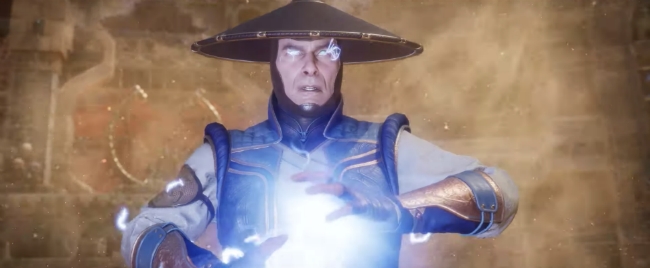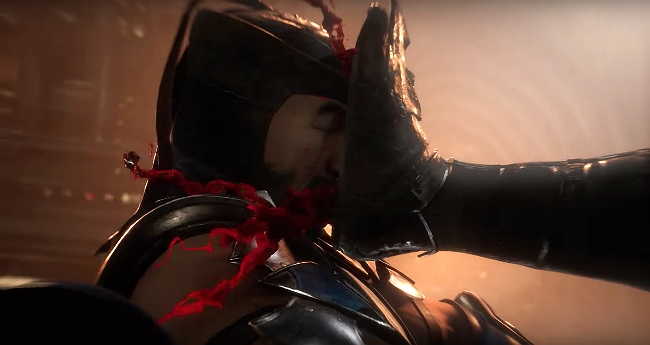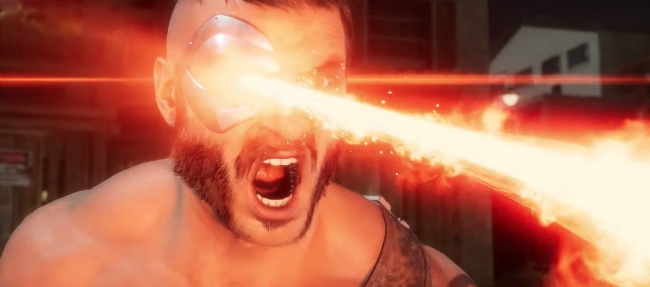
In the first battle of Mortal Kombat 11‘s story mode, Cassie Cage fights her mom while her dad watches the bloodshed. Cassie is made Special Forces commander by Sonya Blade, her mother and commanding officer. But the promotion comes with a tradition that Sonya says can’t be ignored by “family favors.”
“I need to kick the CO’s ass, ma’am'” Cage says. ‘Your ass, ma’am.”
And so the camera pans to the traditional 2.5D fighting game angle and you fight. Tutorial notwithstanding, your first real Mortal Kombat 11 experience is a military battle between mother and daughter. If you execute Cassie Cage’s throw move correctly, you can grab Sonya, her mother, from behind while a drone sizes her up and fires a laser into her groin. Cassie then pulls out a gun and shoots her mother in the back of the head. It does some damage — about an eighth of her total health bar — but then she gets up and keeps fighting her daughter without an exit wound or a fried groin in sight.
Sonya’s throw move, if you let her execute it, has her toss a live grenade on the ground and throws you into it before it explodes. You see where I’m going with this. Mortal Kombat is not a series that values realism, but the entire premise of a mother-daughter fight is completely ridiculous. It’s also comically violent for a game that features realistic-looking brutality. And this is all before there are multiple Luke Cages and Sonyas on screen and things get all time travel-y.

The blood and gore in Mortal Kombat 11 is so extreme it’s downright comedic. One of the game’s new features is the Fatal Blow. It kicks in when your character’s health is low and, if activated, triggers an extremely graphic and unique sequence of ways you dismember and blood-let your opponent. Many of these sequences are far more graphic than the Fatalities that make the game infamous. And they’re a lot easier to pull off — if characters are strategic about it, they’ll each use one during a three-round fight. They’re almost guaranteed to happen, just a trigger pull away.
But Fatal Blows aren’t necessarily fatal at all. If your opponent isn’t at a low enough health, after you put a giant spike through their jaw or stab them with a spear made of blood, you just go right back to the fight like nothing happened. The Mortal Kombat series has long been the subject of controversy for its gore and violence, but perhaps amazingly the violence here doesn’t matter. It’s so over-the-top, so graphic and disorienting that it becomes cartoonish. There are no consequences, not even death.
Now I know what you’re thinking — it’s Mortal Kombat, dude. Nothing about fighting competitions and inter-realm wars makes any goddamn sense. And it’s not supposed to be realistic. But it’s the most disorienting thing about what’s otherwise a very solid modern fighting game with a tutorial mode that’s nimble enough to make new users feel like they’re actually learning how to play a fighting game. And that’s important because, well, I didn’t come to a review of Mortal Kombat 11 with a wealth of traditional fighting game experience to rely on.
Growing up I was far more into Sonic the Hedgehog 2 than Mortal Kombat when it came to games on the Sega Genesis. I had parents worried about violent games and movies — I even had a V-Chipped TV in my bedroom for a while. It didn’t stop me from seeing R-rated movies and playing video games, but there’s no nostalgia for pixelated blood or even the characters of the series for me. And so when Kotal Khan takes his massive sword, stabs someone in the chest with it and then slices back and forth before we return to an otherwise ho-hum fight, I go back to how absurd it is more than anything.
There are some things worth discussing, including the grinding nature of the game once you beat the main story mode. If you’re interested in unlocking different costumes and collecting the game’s various “kurrency” to exchange for songs and whatnot, it’s going to take you some time. And then there’s the various DLCs that are now starting to trickle out and will keep the game profitable thanks to those who are completionists.
That the game isn’t notable for its violence — a violence that has its ante upped in the latest version — is telling. I’m an adult now — it’s not supposed to phase me. But the +1 nature of the violence in Mortal Kombat 11 makes it difficult not to wonder what’s next for a series that mixed its past with the present in a fairly cohesive way to form an evolution of sorts while still finding nostalgic moments. And whether it’s even worth raising the stakes anymore. Are we so awash in violence in the world around us that it all fades into the background?

In one of the pivotal scenes of John Wick 3, guns are simply not enough. A small army of men all have on body armor, meaning a gunshot barely makes an impact on a target. A bruise, maybe, but helmet-wearing men don’t budge as rounds are entered into their bodies, and as they fire back the suggestion is that normal bullets aren’t good enough to end a life. As characters go find higher-powered weapons to kill their opponents, I thought back to the one-upping in Mortal Kombat 11 and the way Fatal Blows change the game, so to speak.
Nothing about John Wick tethers it to the real world — not the clandestine gold coin economy or the idea that the entire planet could support an assassin talent pool that big nor the impossible things Keanu Reeves’ character has apparently survived over the franchise’s three movie run. It’s not supposed to be real, even if large parts of the cinematic universe take place in New York City. And much like Mortal Kombat, that untethering is supposed to make it impossible to compare with reality.
But these are games and movies that are made in reality, and it all does make an impact. The people that made Mortal Kombat 11 described the “extremely graphic” dreams they would have after spending long hours producing the gore we as adults shrug off as comedic once the shock wears off. And after watching all three John Wick movies in a 24 hour period, you can’t help but double take and look suspicious of completely ordinary people while waiting for the train.
Weeks after the game’s release, and well after I put story mode away for good and abandoned any quest for Kombat Kurrency, I was working by a pool when I heard the familiar scream of “FINISH HIM.” A young boy, no more than 10, was reenacting Fatalities, splashing about in the pool while others were trying to catch some sun. He had clearly played some Mortal Kombat recently, and something tells me it wasn’t on a Sega Genesis.
In a world where nostalgia may be the strongest currency in pop culture, the blood won’t be nearly as pixelated when he longs for the fighting games of yesterday. It’s hard to imagine what the next step is from here, but it’s hard to imagine anything can come from not even death mattering all that much.
